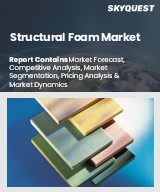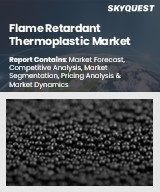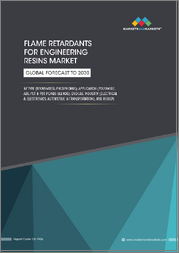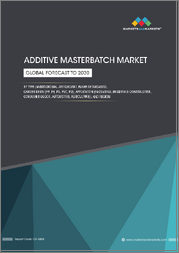
|
시장보고서
상품코드
1822326
세계의 난연제 시장 : 예측 - 유형별, 용도별, 최종 사용자별, 지역별 분석(-2032년)Flame Retardants Market Forecasts to 2032 - Global Analysis By Type, Application, End User and By Geography |
||||||
Stratistics MRC에 따르면 세계의 난연제 시장은 2025년에 109억 달러로 추정되고, 예측 기간 동안 CAGR 8.1%로 성장할 전망이며, 2032년에는 188억 달러에 이를 전망입니다.
난연제는 화염의 발화와 확산을 최소화하거나 방지하기 위해 개발된 화학물질로, 많은 용도 분야에서 안전성을 향상시킵니다. 난연제는 일반적으로 전자기기, 섬유 제품, 플라스틱, 건축, 가구 등에 사용되며, 방화 기준을 충족하는 데 중요한 역할을 합니다. 이러한 화학물질은 연소를 억제하고, 단열층을 형성하며, 화재 억제 가스를 방출하거나, 탄화물의 형성을 촉진하여 연소를 지연시킴으로써 작용합니다. 안전규제 강화, 급속한 산업화, 화재 위험에 대한 의식이 높아짐에 따라 수요가 증가하고 있습니다.
미국 소비자제품안전위원회(CPSC)에 따르면 16 CFR Part 1633은 매트리스 세트에 30분간의 직화 테스트를 의무화하고 있습니다. 그 목적은 그 사이에 발생하는 불의 크기와 강도를 제한하는 것이며, 반드시 매트리스가 불타지 않고 30분 동안 불을 견딜 수 있도록 보장하는 것은 아닙니다.
건설 및 인프라 개발 성장
건설 및 인프라 정비 프로젝트의 가속은 난연제 시장의 중요한 성장 요인입니다. 신흥국에서는 도시화가 진행되고 있어 안전 규제에 적합한 내화성 건축 자재에 대한 수요가 높아지고 있습니다. 난연제의 단열재, 전선, 바닥재, 구조 부재에 대한 용도는 화재의 위험을 방지하고 인명을 지키기 위해 매우 중요합니다. 안전과 함께 지속가능하고 환경친화적인 난연제의 채택은 그린 빌딩의 확대와 함께 중요성을 증가시키고 있습니다. 주택, 상업, 산업의 신흥국 시장 개발에 많은 투자가 이루어지고 있는 가운데, 건설 부문은 난연제 솔루션에 대한 의존도를 높여 세계 시장 수요를 강화하고 있습니다.
친환경 대체품의 고비용
시장의 지속 가능한 난연제로의 전환은 환경 친화적인 대체품의 비용이 상대적으로 높은 것이 억제요인이 되었습니다. 이러한 대체품은 첨단 화학 공학, 특수 원료, 보다 비싼 생산 기술을 포함하는 경우가 많으며, 비용에 민감한 산업에서는 사용하기가 어렵습니다. 섬유 및 소비재와 같이 이익률이 얇은 분야의 기업은 이러한 해결책을 채택하는 데 있어서 과제에 직면하고 있습니다. 특히 중소 제조업체는 비용이 높기 때문에 기존 제품으로부터의 이행이 지연되어 큰 영향을 받습니다. 대규모 생산이 제한되어 있기 때문에 규모의 경제로 인한 비용 절감이 더욱 진행되지 않습니다. 그 결과, 경비 증가가 주된 억제요인이 되어, 친환경 소재의 신속한 채용이 제한되고 있습니다.
친환경 난연제에 대한 수요 증가
지속가능성의 동향은 난연제 시장, 특히 환경친화적인 제형에 큰 기회를 가져옵니다. 독성이 있는 할로겐계 난연제에 대한 규제가 강화됨에 따라 인, 질소, 미네랄 기반 솔루션 등 보다 안전한 옵션에 대한 수요가 증가하고 있습니다. 소비자도 산업계도 마찬가지로 그린 제품을 지지해 다양한 분야에서의 채용을 뒷받침하고 있습니다. 이 시프트는 안전 및 환경 기준이 엄격한 녹색 건설, 전기 이동성 및 전자 장비 제조에서 특히 두드러집니다. 혁신적이고 지속 가능한 고성능 난연제 개발을 선호하는 기업은 큰 이익을 얻을 수 있습니다. 규제 준수와 소비자 선호도를 모두 충족함으로써 성장하는 세계 시장에서 경쟁 우위를 확보할 수 있습니다.
엄격한 규제 압력
세계적인 규제 체제는 기존의 할로겐 제품이 규제 강화에 직면하고 있기 때문에 난연제 산업에 큰 위협이 되고 있습니다. 생태계에 대한 악영향, 환경 잔여, 인체 위험에 대한 우려로 인해 특히 북미와 유럽에서는 사용 금지와 엄격한 규제가 이루어지고 있습니다. 이러한 규제 상황에 따라 생산자는 일반적인 화합물의 제조 중단 및 재제조를 강요하고 컴플라이언스 및 기술 혁신 비용이 증가하고 있습니다. 소규모 기업에서는 리소스가 제한되어 있기 때문에 이러한 마이그레이션을 관리하는 데 어려움을 겪습니다. 이러한 진화 기준은 기존 제형의 범위를 좁히고, 사업의 연속성을 저해하며, 장기적인 사업에 불확실성을 가져오고, 시장의 지속가능성에 심각한 과제를 던지고 있습니다.
COVID-19의 영향 :
세계의 난연제 시장은 COVID-19의 영향을 크게 받아 자동차, 건설, 일렉트로닉스 등의 주요 분야에서 공급망의 혼란과 수요의 침체가 확산되고 있습니다. 장시간 가동 중단은 생산 라인을 멈추고 프로젝트를 지연시키며 전반적인 소비 수준을 낮추었습니다. 제조업체는 원재료 부족과 운송 지연으로 인한 비용 상승에도 직면했습니다. 이러한 좌절에도 불구하고이 위기는 탄력있는 공급망과 친환경 제제에 대한 주력을 촉진하고 장기적인 혁신을 촉진했습니다. 세계 경제 활동이 재개됨에 따라 산업계는 인프라 개발 및 전자 제조업을 중심으로 회복되고 있습니다. 이 회복은 난연제 시장을 안정시키고 재성장을 지원할 것으로 기대됩니다.
예측 기간 동안 삼수화알루미늄(ATH) 부문이 최대가 될 전망
예측 기간 동안 삼수화알루미늄(ATH) 부문이 가장 큰 시장 점유율을 차지할 전망입니다. 삼수화알루미늄(ATH)은 광범위한 적용성, 저렴한 가격, 환경적으로 안전한 프로파일로 난연제 시장을 독점하고 있습니다. ATH는 건축자재, 플라스틱, 섬유 제품 및 고무 제품에 널리 사용되며 할로겐이 없는 효과적인 솔루션으로 사용됩니다. ATH는 연소 중에 물을 방출하여 화염 강도를 낮추고 연기 발생을 억제하며 내화성을 향상시킵니다. 무독성이기 때문에 엄격한 안전 및 환경 규제 하에서도 유리하게 작동합니다. ATH는 난연성뿐만 아니라 최종 제품의 단열성과 내구성 향상에도 기여합니다. 지속가능하고 컴플라이언스에 적합한 난연성 재료에 대한 선호도가 높아짐에 따라 ATH는 세계적인 용도에서 선도하는 부문으로서 확고한 지위를 구축하고 있습니다.
폴리우레탄 폼 분야는 예측 기간 중 가장 높은 CAGR이 예상됩니다.
예측 기간 동안 폴리우레탄 폼 분야는 자동차, 건축, 가구, 단열재 산업의 광범위한 수요에 힘입어 가장 높은 성장률을 보일 것으로 예측됩니다. 폴리우레탄 폼은 가연성이 높기 때문에 규제 및 안전 기준을 충족시키기 위해 난연제를 첨가해야 합니다. 지속 가능한 건설, 에너지 효율적인 주택, 경량 자동차 부품에 대한 관심 증가는 난연성 폴리우레탄 폼의 요구를 뒷받침하고 있습니다. 연질 및 경질 폼의 양 유형 모두 폭넓은 용도가 있어, 범용성 및 시장 소구력을 높이고 있습니다. 도시개발의 진행과 안전규제의 강화에 따라 난연가공 폴리우레탄 제품에 대한 수요가 급증하고 있으며, 이 분야는 세계적으로 가장 급성장하고 있습니다.
최대 점유율을 차지하는 지역 :
예측 기간 동안 아시아태평양이 가장 큰 시장 점유율을 차지할 것으로 예측됩니다. 이것은 급속한 도시화, 산업 성장, 자동차, 전자 제품, 건설, 섬유 산업의 확대에 의해 지원됩니다. 인구 수준 상승, 소득 증가, 정부 지원을 통한 대규모 인프라 프로젝트가 시장 수요를 추진하고 있습니다. 또한 안전규제의 강화와 화재 위험에 대한 의식의 고조도 각 용도에서의 채용을 뒷받침하고 있습니다. 중국, 인도, 한국, 일본을 포함한 국가들은 광범위한 제조 부문과 플라스틱, 발포체, 건축 제품의 다용도로 주도적인 역할을 수행하고 있습니다. 또한 비용 효율적인 노동력과 자원 가용성은 아시아태평양의 리더십을 강화하여 세계 시장에서의 우위를 확실히 하고 있습니다.
CAGR이 가장 높은 지역 :
예측 기간 동안 중동 및 아프리카가 가장 높은 CAGR을 나타낼 것으로 예측됩니다. 이는 건설 활동의 활성화, 산업 개발, 정부지원에 의한 근대화 프로젝트에 의한 것입니다. 도시 인구의 확대 및 화재 안전법의 엄격화로 인프라, 운송, 가정용으로 난연성 제품에 대한 수요가 높아지고 있습니다. 걸프 국가의 경제 다양화로 자동차, 전자기기 및 제조업에서의 사용이 확대되고 있습니다. 화재 안전에 대한 의식의 고조와 규제의 진화가 함께, 채용이 더욱 진행되고 있습니다. 이 지역은 아직 미개척의 커다란 성장 잠재력을 지니고 있으며, 세계에서 가장 역동적이고 빠르게 성장하는 난연제 시장으로 부상하고 있습니다.
무료 맞춤형 서비스
이 보고서를 구독하는 고객은 다음 무료 맞춤설정 옵션 중 하나를 사용할 수 있습니다.
- 기업 프로파일
- 추가 시장 기업의 종합적 프로파일링(3개사까지)
- 주요 기업의 SWOT 분석(3개사까지)
- 지역 세분화
- 고객의 관심에 응한 주요국 시장 추계, 예측 및 CAGR(주 : 타당성 확인에 따름)
- 경쟁 벤치마킹
- 제품 포트폴리오, 지리적 존재, 전략적 제휴에 기반한 주요 기업 벤치마킹
목차
제1장 주요 요약
제2장 서문
- 개요
- 이해관계자
- 조사 범위
- 조사 방법
- 데이터 마이닝
- 데이터 분석
- 데이터 검증
- 조사 접근
- 조사 자료
- 1차 조사 자료
- 2차 조사 정보원
- 전제조건
제3장 시장 동향 분석
- 성장 촉진요인
- 성장 억제요인
- 기회
- 위협
- 용도 분석
- 최종 사용자 분석
- 신흥 시장
- COVID-19의 영향
제4장 Porter's Five Forces 분석
- 공급기업의 협상력
- 구매자의 협상력
- 대체품의 위협
- 신규 참가업체의 위협
- 경쟁 기업간 경쟁 관계
제5장 세계의 난연제 시장 : 유형별
- 삼수화 알루미늄(ATH)
- 산화안티몬
- 브롬계 난연제
- 인계 난연제
- 질소계 난연제
- 염소계 난연제
- 무기 난연제
- 기타 유형
제6장 세계의 난연제 시장 : 용도별
- 에폭시 수지
- 폴리올레핀
- 불포화 폴리에스테르 수지
- 폴리염화비닐(PVC)
- 폴리우레탄 폼
- 고무와 엘라스토머
- 열경화성 수지 및 열가소성 수지
- 기타 용도
제7장 세계의 난연제 시장 : 최종 사용자별
- 건축 및 건설
- 전자기기 및 전기기기
- 자동차 및 운송
- 섬유 및 가구
- 와이어 및 케이블
- 항공우주 및 방위
- 산업기기
- 포장
제8장 세계의 난연제 시장 : 지역별
- 북미
- 미국
- 캐나다
- 멕시코
- 유럽
- 독일
- 영국
- 이탈리아
- 프랑스
- 스페인
- 기타 유럽
- 아시아태평양
- 일본
- 중국
- 인도
- 호주
- 뉴질랜드
- 한국
- 기타 아시아태평양
- 남미
- 아르헨티나
- 브라질
- 칠레
- 기타 남미
- 중동 및 아프리카
- 사우디아라비아
- 아랍에미리트(UAE)
- 카타르
- 남아프리카
- 기타 중동 및 아프리카
제9장 주요 발전
- 계약, 파트너십, 협업 및 합작투자
- 인수 및 합병
- 신제품 발매
- 사업 확대
- 기타 주요 전략
제10장 기업 프로파일링
- Albemarle Corporation
- ICL Group
- LANXESS
- Clariant AG
- BASF SE
- Italmatch Chemicals SpA
- Huber Engineered Materials
- Thor
- DSM
- DuPont de Nemours
- DOW
- JM Huber Corporation
- Nabaltec AG
- MPI Chemie BV
- Apexical Inc
According to Stratistics MRC, the Global Flame Retardants Market is accounted for $10.90 billion in 2025 and is expected to reach $18.80 billion by 2032 growing at a CAGR of 8.1% during the forecast period. Flame retardants are chemical substances developed to minimize or stop the ignition and spread of flames, thereby improving safety in numerous applications. Commonly used in electronics, textiles, plastics, construction, and home furnishings, they play a critical role in meeting fire protection standards. These chemicals act by disrupting combustion, forming insulation layers, releasing fire-suppressing gases, or encouraging char formation to slow burning. Their demand is increasing due to stricter safety regulations, rapid industrialization, and heightened fire risk awareness.
According to the U.S. Consumer Product Safety Commission (CPSC), 16 CFR Part 1633 does require mattress sets to undergo a 30-minute open flame test. The purpose is to limit the size and intensity of the fire generated during that time, not necessarily to ensure the mattress "withstands" fire for 30 minutes without burning.
Market Dynamics:
Driver:
Growth in construction and infrastructure development
The accelerating pace of construction and infrastructure projects is a vital growth factor for the flame retardants market. Emerging economies are witnessing rising urbanization, creating strong demand for fire-resistant construction materials that comply with safety regulations. Applications of flame retardants in insulation, wires, flooring, and structural elements are crucial to prevent fire hazards and safeguard lives. Alongside safety, the adoption of sustainable and environmentally friendly flame retardants is gaining importance with the expansion of green building practices. With significant investments in residential, commercial, and industrial developments, the construction sector is increasingly reliant on flame retardant solutions, reinforcing their global market demand.
Restraint:
High costs of eco-friendly alternatives
The market's shift toward sustainable flame retardants is restrained by the comparatively higher costs of eco-friendly options. These alternatives often involve advanced chemical engineering, specialized raw materials, and more expensive production techniques, making them less accessible to cost-sensitive industries. Companies in sectors like textiles and consumer goods with thin profit margins face challenges in adopting such solutions. Smaller manufacturers are especially impacted, as the high costs slow down their ability to transition from conventional products. Limited large-scale production further prevents cost reduction through economies of scale. Consequently, elevated expenses act as a key restraint, limiting faster adoption of greener materials.
Opportunity:
Rising demand for eco-friendly flame retardants
Sustainability trends are opening significant opportunities in the flame retardants market, especially for eco-friendly formulations. As regulations tighten against toxic halogenated variants, demand is rising for safer options like phosphorus, nitrogen, and mineral-based solutions. Consumers and industries alike are favoring green products, boosting adoption across multiple sectors. This shift is particularly strong in green construction, electric mobility, and electronics manufacturing, where safety and environmental standards are strict. Companies that prioritize the development of innovative, sustainable, and high-performance flame retardants stand to benefit greatly. By addressing both regulatory compliance and consumer preferences, they gain competitive advantages in a growing global market.
Threat:
Stringent regulatory pressures
Global regulatory frameworks pose a major threat to the flame retardants industry, as traditional halogen-based products face heightened restrictions. Concerns over ecological harm, persistence in the environment, and risks to human health have prompted bans and tight controls, especially across North America and Europe. This regulatory landscape forces producers to either discontinue or reformulate popular compounds, leading to rising compliance and innovation costs. Smaller firms often struggle to manage such transitions due to limited resources. These evolving standards reduce the scope of traditional formulations, disrupt business continuity, and introduce uncertainty into long-term operations, posing a serious challenge for market sustainability.
Covid-19 Impact:
The global flame retardants market was significantly affected by COVID-19, with widespread supply chain disruptions and weakened demand across major sectors like automotive, construction, and electronics. Extended lockdowns halted production lines, delayed projects, and reduced overall consumption levels. Manufacturers also faced higher costs due to raw material shortages and transportation delays. Despite these setbacks, the crisis prompted a stronger focus on resilient supply chains and environmentally friendly formulations, fostering long-term innovation. With economic activities resuming worldwide, industries are witnessing recovery, especially in infrastructure development and electronics manufacturing. This rebound is expected to stabilize the flame retardants market and support renewed growth.
The aluminum trihydrate (ATH) segment is expected to be the largest during the forecast period
The aluminum trihydrate (ATH) segment is expected to account for the largest market share during the forecast period. Aluminum Trihydrate (ATH) dominates the flame retardants market owing to its broad applicability, affordability, and environmentally safe profile. It is extensively utilized in construction materials, plastics, textiles, and rubber products, serving as an effective halogen-free solution. ATH works by releasing water during combustion, which lowers flame intensity, reduces smoke formation, and enhances fire resistance. Its non-toxic characteristics make it favorable under stringent safety and environmental regulations. Beyond flame protection, ATH contributes to better insulation and durability in finished products. The rising preference for sustainable and compliant flame retardant materials has firmly established ATH as the leading segment across global applications.
The polyurethane foams segment is expected to have the highest CAGR during the forecast period
Over the forecast period, the polyurethane foams segment is predicted to witness the highest growth rate, supported by extensive demand in automotive, construction, furniture, and insulation industries. Given their high flammability, these foams require the incorporation of flame retardants to meet regulatory and safety standards. Increasing focus on sustainable construction, energy-efficient housing, and lightweight vehicle components is propelling the need for flame-retardant polyurethane foams. Both flexible and rigid foam types find broad applications, enhancing versatility and market appeal. With ongoing urban development and stricter safety regulations, the demand for flame retardant-treated polyurethane products is surging, positioning this segment as the fastest-growing globally.
Region with largest share:
During the forecast period, the Asia Pacific region is expected to hold the largest market share, supported by swift urbanization, industrial growth, and the expansion of automotive, electronics, construction, and textile industries. Rising population levels, increasing income, and large-scale government-backed infrastructure projects are fueling market demand. Enhanced safety regulations and greater awareness of fire risks are also pushing adoption across applications. Countries including China, India, South Korea, and Japan play leading roles, owing to their vast manufacturing sectors and heavy use of plastics, foams, and building products. Additionally, cost-effective labor and resource availability strengthen Asia-Pacific's leadership, ensuring its dominance in the global market.
Region with highest CAGR:
Over the forecast period, the Middle East & Africa region is anticipated to exhibit the highest CAGR, driven by rising construction activities, industrial development, and government-backed modernization projects. Urban population expansion and stricter fire safety laws are creating strong demand for flame-retardant products in infrastructure, transport, and household applications. Economic diversification efforts in Gulf nations are expanding usage in automotive, electronics, and manufacturing industries. Growing fire safety awareness, combined with evolving regulations, is further pushing adoption. With significant growth potential still untapped, this region is emerging as the most dynamic and rapidly expanding market for flame retardants worldwide.
Key players in the market
Some of the key players in Flame Retardants Market include Albemarle Corporation, ICL Group, LANXESS, Clariant AG, BASF SE, Italmatch Chemicals S.p.A, Huber Engineered Materials, Thor, DSM, DuPont de Nemours, DOW, J.M. Huber Corporation, Nabaltec AG, MPI Chemie BV and Apexical Inc.
Key Developments:
In July 2025, Clariant announced that it has signed a strategic cooperation agreement with Shanghai Boiler Works, a full subsidiary of Shanghai Electric, specializing in energy conversion and the development of new energy applications, to jointly foster innovation in sustainable energy solutions. The partners will combine their expertise to advance green energy projects in China. The agreement is the result of close and successful cooperation in Shanghai Electric's new biomass-to-green methanol plant in Taonan, Jilin Province, China.
In January 2025, ICL announced it has signed a joint venture (JV) agreement with Shenzhen Dynanonic Co., Ltd. to establish lithium iron phosphate (LFP) cathode active material (CAM) production in Europe, with an initial investment of approximately €285 million. A new facility at ICL's Sallent, Spain, site is currently in planning stages and will substantially expand the company's battery materials business.
In May 2024, Albemarle Corporation announced an innovative agreement with Martin Marietta Materials, Inc to make beneficial use of extracted limestone material from Albemarle's proposed Kings Mountain Mine project. This agreement is part of Albemarle's plan to resume lithium mining operations at the Kings Mountain Mine in an environmentally and socially responsible manner, including opportunities to repurpose byproduct material and enhance the economic benefits for the surrounding community.
Types Covered:
- Aluminum Trihydrate (ATH)
- Antimony Oxide
- Brominated Flame Retardants
- Phosphorus-Based Flame Retardants
- Nitrogen-Based Flame Retardants
- Chlorinated Flame Retardants
- Inorganic Flame Retardants
- Other Types
Applications Covered:
- Epoxy Resins
- Polyolefins
- Unsaturated Polyester Resins
- Polyvinyl Chloride (PVC)
- Polyurethane Foams
- Rubber & Elastomers
- Thermosets & Thermoplastics
- Other Applications
End Users Covered:
- Building & Construction
- Electronics & Electrical Appliances
- Automotive & Transportation
- Textiles & Furnishings
- Wire & Cable
- Aerospace & Defense
- Industrial Equipment
- Packaging
Regions Covered:
- North America
- US
- Canada
- Mexico
- Europe
- Germany
- UK
- Italy
- France
- Spain
- Rest of Europe
- Asia Pacific
- Japan
- China
- India
- Australia
- New Zealand
- South Korea
- Rest of Asia Pacific
- South America
- Argentina
- Brazil
- Chile
- Rest of South America
- Middle East & Africa
- Saudi Arabia
- UAE
- Qatar
- South Africa
- Rest of Middle East & Africa
What our report offers:
- Market share assessments for the regional and country-level segments
- Strategic recommendations for the new entrants
- Covers Market data for the years 2024, 2025, 2026, 2028, and 2032
- Market Trends (Drivers, Constraints, Opportunities, Threats, Challenges, Investment Opportunities, and recommendations)
- Strategic recommendations in key business segments based on the market estimations
- Competitive landscaping mapping the key common trends
- Company profiling with detailed strategies, financials, and recent developments
- Supply chain trends mapping the latest technological advancements
Free Customization Offerings:
All the customers of this report will be entitled to receive one of the following free customization options:
- Company Profiling
- Comprehensive profiling of additional market players (up to 3)
- SWOT Analysis of key players (up to 3)
- Regional Segmentation
- Market estimations, Forecasts and CAGR of any prominent country as per the client's interest (Note: Depends on feasibility check)
- Competitive Benchmarking
- Benchmarking of key players based on product portfolio, geographical presence, and strategic alliances
Table of Contents
1 Executive Summary
2 Preface
- 2.1 Abstract
- 2.2 Stake Holders
- 2.3 Research Scope
- 2.4 Research Methodology
- 2.4.1 Data Mining
- 2.4.2 Data Analysis
- 2.4.3 Data Validation
- 2.4.4 Research Approach
- 2.5 Research Sources
- 2.5.1 Primary Research Sources
- 2.5.2 Secondary Research Sources
- 2.5.3 Assumptions
3 Market Trend Analysis
- 3.1 Introduction
- 3.2 Drivers
- 3.3 Restraints
- 3.4 Opportunities
- 3.5 Threats
- 3.6 Application Analysis
- 3.7 End User Analysis
- 3.8 Emerging Markets
- 3.9 Impact of Covid-19
4 Porters Five Force Analysis
- 4.1 Bargaining power of suppliers
- 4.2 Bargaining power of buyers
- 4.3 Threat of substitutes
- 4.4 Threat of new entrants
- 4.5 Competitive rivalry
5 Global Flame Retardants Market, By Type
- 5.1 Introduction
- 5.2 Aluminum Trihydrate (ATH)
- 5.3 Antimony Oxide
- 5.4 Brominated Flame Retardants
- 5.5 Phosphorus-Based Flame Retardants
- 5.6 Nitrogen-Based Flame Retardants
- 5.7 Chlorinated Flame Retardants
- 5.8 Inorganic Flame Retardants
- 5.9 Other Types
6 Global Flame Retardants Market, By Application
- 6.1 Introduction
- 6.2 Epoxy Resins
- 6.3 Polyolefins
- 6.4 Unsaturated Polyester Resins
- 6.5 Polyvinyl Chloride (PVC)
- 6.6 Polyurethane Foams
- 6.7 Rubber & Elastomers
- 6.8 Thermosets & Thermoplastics
- 6.9 Other Applications
7 Global Flame Retardants Market, By End User
- 7.1 Introduction
- 7.2 Building & Construction
- 7.3 Electronics & Electrical Appliances
- 7.4 Automotive & Transportation
- 7.5 Textiles & Furnishings
- 7.6 Wire & Cable
- 7.7 Aerospace & Defense
- 7.8 Industrial Equipment
- 7.9 Packaging
8 Global Flame Retardants Market, By Geography
- 8.1 Introduction
- 8.2 North America
- 8.2.1 US
- 8.2.2 Canada
- 8.2.3 Mexico
- 8.3 Europe
- 8.3.1 Germany
- 8.3.2 UK
- 8.3.3 Italy
- 8.3.4 France
- 8.3.5 Spain
- 8.3.6 Rest of Europe
- 8.4 Asia Pacific
- 8.4.1 Japan
- 8.4.2 China
- 8.4.3 India
- 8.4.4 Australia
- 8.4.5 New Zealand
- 8.4.6 South Korea
- 8.4.7 Rest of Asia Pacific
- 8.5 South America
- 8.5.1 Argentina
- 8.5.2 Brazil
- 8.5.3 Chile
- 8.5.4 Rest of South America
- 8.6 Middle East & Africa
- 8.6.1 Saudi Arabia
- 8.6.2 UAE
- 8.6.3 Qatar
- 8.6.4 South Africa
- 8.6.5 Rest of Middle East & Africa
9 Key Developments
- 9.1 Agreements, Partnerships, Collaborations and Joint Ventures
- 9.2 Acquisitions & Mergers
- 9.3 New Product Launch
- 9.4 Expansions
- 9.5 Other Key Strategies
10 Company Profiling
- 10.1 Albemarle Corporation
- 10.2 ICL Group
- 10.3 LANXESS
- 10.4 Clariant AG
- 10.5 BASF SE
- 10.6 Italmatch Chemicals S.p.A
- 10.7 Huber Engineered Materials
- 10.8 Thor
- 10.9 DSM
- 10.10 DuPont de Nemours
- 10.11 DOW
- 10.12 J.M. Huber Corporation
- 10.13 Nabaltec AG
- 10.14 MPI Chemie BV
- 10.15 Apexical Inc



















